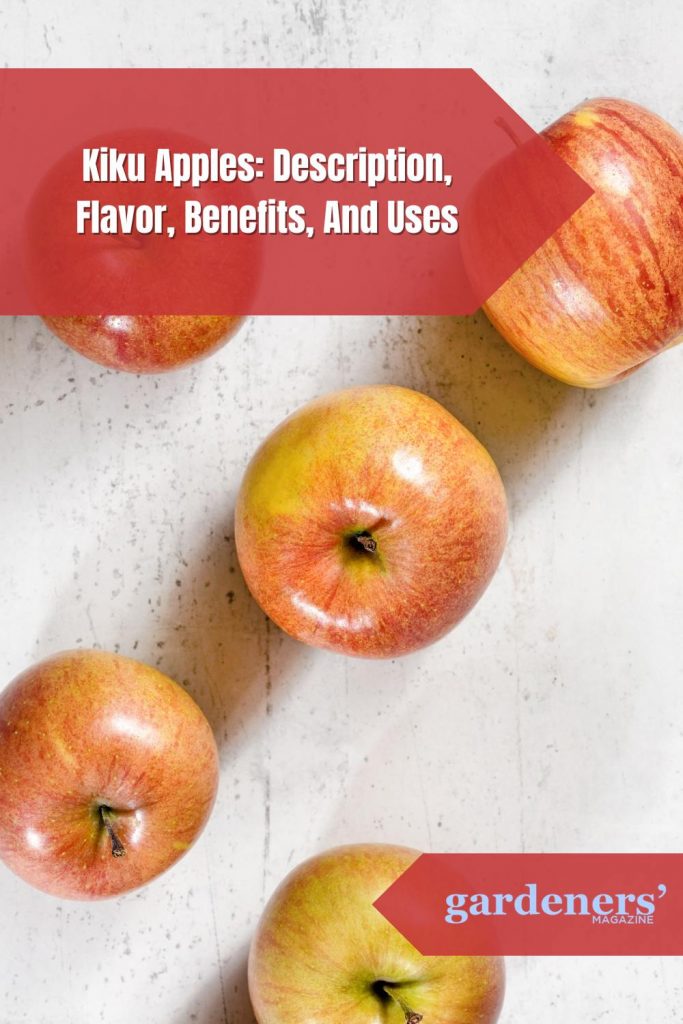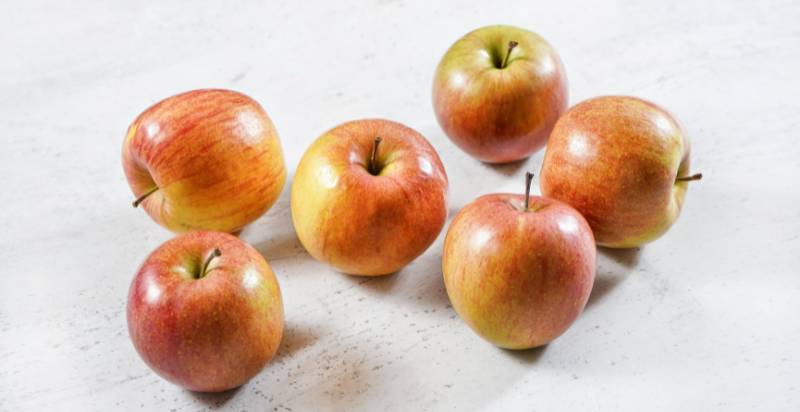Kiku apples originated from Japan and are recognized for their sweet yet tart taste. Kiku apples are also Japanese Imperial Apples or “Hana-koku” in Japanese. This particular type of apple is unique because it has a round shape with green/yellow skin and crisp white flesh. Additionally, Kiku apples are considered one of the best-tasting apples in the world and are full of antioxidants, vitamins, and minerals. Here is everything you need to know about the Kiku apple.
What are Kiku Apples?
Kiku apples are a type of crisp, sweet-tart apple originating from Japan. The name Kiku comes from the Japanese word “chrysanthemum,” about the five-petal patterns on the apple’s skin. These apples have an exceptionally short shelf-life and must be eaten within a few weeks of the harvest to enjoy their full flavor.
Kiku apples have a firmer and crunchier texture than other apple varieties, with a sweet-tart flavor and pleasant aroma. They are delicious eaten raw or cooked into pies, sauces, and compotes. These unique apples are also great for juicing or blending into smoothies for an extra boost of sweetness.

History and Origin of Kiku Apples:
Kiku apples are a hybrid breed of apple, originally developed in Japan in the 1940s by crossbreeding two varieties of Fuji apples. They were given their name, “Kiku,” after the Japanese word for chrysanthemum, as it was thought they resembled this flower due to their deep pink color. In addition to being attractive, Kiku apples are also known for their juicy texture and sweet flavor, making them a popular choice among apple lovers. Kiku apples have become increasingly popular in Japan, where they are now the second-most widely produced variety of apples after the Fuji.
The popularity of these delicious fruits has spread internationally as well; Kiku apples are now grown in China, India, South Korea, and the United States. They are a great addition to any meal, from salads to desserts, adding flavor and nutrition. Whether looking for that perfect balance of sweet and sour or want to enjoy a nutritious snack, Kiku apples will satisfy your cravings.
Description of the Kiku Apples:
Kiku apples are medium-sized fruits that measure approximately 6 to 7 cm in diameter. The apple’s skin is smooth and glossy, with a yellow/green coloration and reddish blush. When ripe, it has a sweet flavor and crisp texture, making it an ideal snack or ingredient for cooking dishes such as pies or sauces. Its firm flesh holds its shape well when cooked, and its acidity balances out flavors in various recipes.
Kiku apple trees are also generally easy to care for. The trees tend to be smaller than other types of apples, growing up to 4 to 5 meters in height, and can often survive with minimal water and fertilizer. Kiku’s yield is usually good, bearing large clusters of fruits each year. However, their relatively small size means Kiku apples must be harvested at their peak ripeness to ensure the best flavor.
Flavor Profile of Kiku Apples:
Kiku apples are known for their sweet and fragrant aroma and unique flavor profile that combines tartness with sweetness. They have a firm texture and are juicy to the bite. The flesh of Kiku apples is creamy white when ripe. The taste can be described as a mix between honey and pineapple with an underlying hint of citrus. Its aroma is floral and fruity, with cantaloupe, pear, and lemon notes.
Kiku apples are great for snacking or baking into pies and crisps. They can also be used in salads and salsas to add sweetness with a unique twist. Their intense flavor makes them an ideal choice for making apple cider vinegar or apple brandy.
Health Benefits of Kiku Apples:
Kiku apples are a good source of dietary fiber, which helps to regulate digestion and may reduce the risk of certain diseases. They’re also rich in vitamin C and other antioxidants that help to boost the immune system and protect against oxidative stress. Kiku apples contain phytonutrients with anti-inflammatory benefits and can help protect against bacteria and viruses.
Overall, Kiku apples are a nutritious and tasty choice that can be enjoyed in various ways. The unique flavor profile makes them a great addition to any meal or snack.
Cultivation of the Kiku Apples:
Kiku apples are a popular fruit in Japan, known for their distinct shape and sweet taste. Farmers must first select suitable land with good soil fertility and adequate water supply to cultivate them commercially. They should then prepare the land by clearing away rocks and weeds and tilling the soil. The orchard should also be kept free of pests and diseases.
Once the land is prepared, farmers should plant Kiku apple trees in rows at least 4 meters apart. The trees need to be spaced far enough apart to ensure adequate sunlight and air circulation for each tree. After planting, it is important to regularly prune the branches to encourage fruiting and reduce disease risk. The orchard must be regularly weeded and watered to ensure healthy growth.
Harvesting of the Kiku Apples:
The harvesting of Kiku apples starts in mid-August and extends to the end of September. During this period, orchardists should wait for the right moment when the fruits are ripe and ready to be harvested. Depending on the variety of Kiku apples, harvesters will pick them at different sizes, usually between 2-3 cm (0.8-1.2 inches) in diameter. The apples are collected by hand or mechanically harvested, depending on the size of the farm and the preferences of the orchardists. On harvest day, fruit pickers will be busy for many hours picking up each Kiku apple carefully from the tree branches without damaging the skin of the fruits. Once picked, these apples are placed into plastic crates and transported to a processing plant for further sorting, grading, packaging, and sale.
Apart from manual harvesting, some farms may also use new advanced technology such as air-level picking (ALP), a semi-mechanical process requiring just one operator to harvest the Kiku apples. In this method, an operator will drive through the orchard in a tractor-mounted machine fitted with an elevated platform. This platform has air jets that blow the mature apples off the tree into collecting containers below. The fruits get removed in one go, eliminating the need for manual climbing of trees and making the harvesting process faster and more efficient. The collected Kiku apples are then transported to a processing plant for further handling.

Where do Kiku Apples Grow?
Kiku apples are a variety of apples that originate from Japan. They are grown primarily in the Chiba Prefecture, located on Honshu Island’s east coast. The apples also have limited production in Nagano and Iwate Prefectures. Kiku apples are often found in specialty shops and grocery stores throughout Japan but can also be shipped worldwide.
Kiku apples have a bright yellow exterior with smooth and sweet-tasting flesh and are typically harvested from October to December. They are best when picked directly from the trees and consumed within a few days of purchase for optimal flavor, but they can also be kept in cool temperatures for up to two weeks if needed.
What are the things you need to keep in mind when buying Kiku Apples?
When buying Kiku apples, a few important points to consider are:
- Variety: Kiku apples come in various shapes and sizes, so knowing which type is best for your needs is important.
- Quality: You should always try to buy the freshest possible fruit and look for signs of bruising or deterioration.
- Storage: Kiku apples should be stored in a cool, dry place away from direct sunlight and heat.
- Preparation: Depending on the type of dish you are making, different methods of preparing your Kiku apples may be necessary to achieve the desired result.
- Pairings: Different varieties of Kiku apples work well with different ingredients and flavors, so it’s important to consider what you plan to serve them with.
Considering these points when buying your Kiku apples, you can get the best quality fruit for your needs. Happy shopping!
What is the Best Way to Store Kiku Apples?
The best way to store Kiku apples is to keep them in a cool, dark place away from sunlight and heat. Store the apples in a plastic bag with small holes punched for ventilation and then place them in the refrigerator or other cool area. Keeping the apples in the refrigerator will help slow their ripening process so they can be eaten over time.
Suppose you don’t have enough fridge space for all your Kiku apples. In that case, you can also wrap each apple individually with newspaper or tissue paper before storing them in a cardboard box or air-tight container away from direct sunlight. Make sure to check on the apples every few days and discard any that show signs of spoilage. With proper storage, Kiku apples should last up to a month or more.
How to Use Kiku Apples in Recipes with others?
Kiku apples can be a great addition to many recipes when combined with other fruits and vegetables. They have a unique sweet-tart flavor that pairs nicely with sweeter items like peaches, nectarines, and bananas.
To make your own recipe using Kiku apples, start by selecting the freshest fruit available and combine them in whatever combination you desire. For a simple dish, try combining diced Kiku apples with diced peaches and chopped fresh mint. You can also add in some lightly sautéed shallots for an extra layer of flavor.
If you’re looking for something with more of a kick, try adding some diced jalapeños or habaneros to the mix. Once your ingredients are all combined, you can serve the mixture over ice cream or in your favorite pie crust. Alternatively, you can bake it into a delicious crumble and top with a scoop of vanilla yogurt for an extra-special treat.
Conclusion:
Kiku apples are a unique and flavorful variety of apples with many uses. Whether you want to eat them fresh, store them for later, or experiment with recipes, these firm-fleshed fruits have something to offer every eater. With proper storage and handling techniques, Kiku apples can last up to a month or more in the right conditions – so you can enjoy their taste and texture for longer! From the kitchen to the lunchbox, Kiku apples are sure to add a touch of sweetness and crunch.
- Everything You Wanted to Know About Red Tamarillos - June 2, 2025
- A Guide to Tulips: Everything You Need to Know & More… - June 2, 2025
- Guanabana: Description, Flavor, Benefits, And Uses - May 27, 2025

8 thoughts on “Kiku Apples: Description, Flavor, Benefits, And Uses”
Comments are closed.